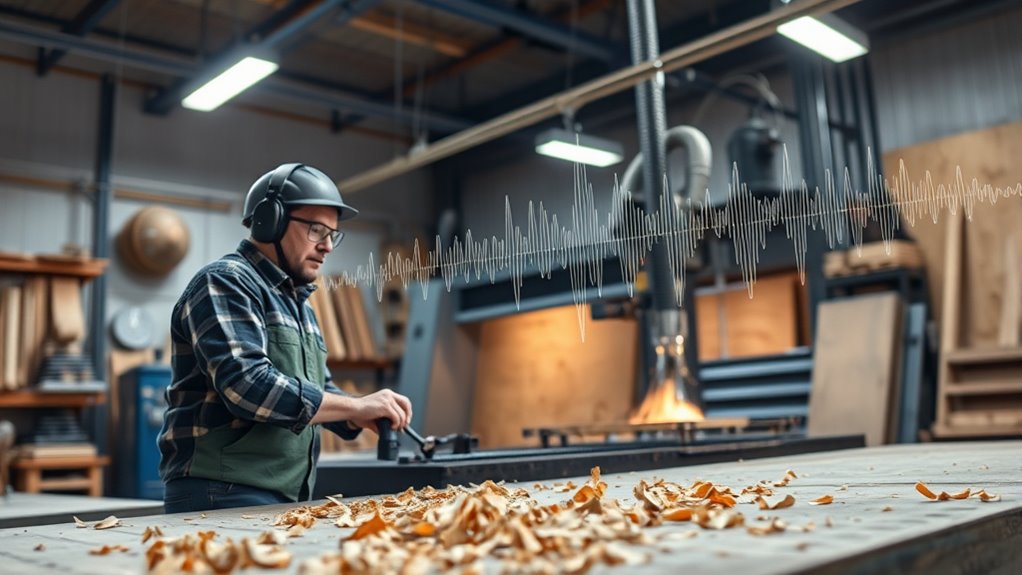AI improves safety in woodworking by using acoustic anomaly detection to monitor your machines constantly. It listens for irregular sounds, vibrations, or tool misfires that could signal a problem early on. This real-time analysis helps prevent accidents, equipment damage, and downtime by alerting you immediately. Implementing this technology creates a safer work environment, and as you explore more, you’ll discover how it integrates seamlessly to protect both operators and tools effectively.
Key Takeaways
- AI uses sound analysis to detect irregularities in machinery, preventing accidents before human operators notice issues.
- Machine learning models continuously improve detection accuracy by learning from ongoing sound data.
- Acoustic anomaly detection provides real-time alerts, enabling immediate response to potential safety hazards.
- Integration with existing sensors creates comprehensive safety systems that enhance overall woodworking safety.
- AI-driven monitoring supports proactive maintenance, reducing downtime and ensuring safer operational environments.

Artificial intelligence is transforming woodworking safety by providing real-time monitoring and tailored safety guidance that actively prevent accidents. One innovative way AI enhances safety is through acoustic anomaly detection, which listens to the sounds generated during woodworking tasks to identify irregularities indicating potential hazards.
By analyzing audio data continuously, AI systems can detect unusual noises such as abnormal machinery vibrations, tool misfires, or components coming loose, often before a human operator notices any issue. This early detection allows for immediate alerts or automated shutdowns, considerably reducing the risk of injury or equipment damage.
AI detects unusual sounds early, triggering alerts to prevent accidents and equipment damage.
When you’re working with complex machinery, it can sometimes be difficult to recognize subtle signs of malfunction. Acoustic anomaly detection addresses this gap by acting as an intelligent auditory watchdog, leveraging advanced sound analysis to ensure safety. The AI system uses machine learning algorithms trained on vast datasets of normal and abnormal sounds, enabling it to distinguish between routine noises and dangerous anomalies rapidly.
As you operate machinery, the system constantly listens, analyzing sound patterns in real time. If it detects a deviation from expected acoustic signatures, it can trigger alarms or halt operations instantly, preventing accidents before they escalate. This proactive approach not only keeps you safe but also minimizes costly downtime caused by unexpected equipment failures.
Integrating acoustic anomaly detection into your woodworking environment is seamless and user-friendly. These AI tools are designed with intuitive interfaces, allowing even beginners to benefit from advanced safety features without extensive training. You get real-time alerts through visual signals or notifications on your device, ensuring you’re always aware of potential issues.
As the system gathers more acoustic data over time, it learns and refines its detection capabilities, making it smarter and more accurate with each use. This continuous improvement means that your safety measures evolve alongside your work practices, adapting to new tools or procedures you might adopt. It also leverages existing sensor technology to create a comprehensive safety network, enhancing the reliability of hazard detection.
Moreover, acoustic anomaly detection forms part of a broader predictive safety framework that leverages AI’s ability to analyze environmental and operational data. By combining sound analysis with other safety features—such as collision avoidance sensors and machine status monitoring—you create a detailed safety net. Additionally, these systems can help identify potential equipment issues early, enabling proactive maintenance and reducing downtime.
This integrated approach reduces incidents, improves operational efficiency, and helps you meet industry safety standards. As AI adoption grows in woodworking, acoustic anomaly detection stands out as an essential technology that actively listens, learns, and responds to keep you safe in the workshop. Utilizing machine learning algorithms further enhances the system’s ability to adapt to new sounds and operational changes over time.
Conclusion
By implementing acoustic anomaly detection, you substantially boost safety in woodworking, catching issues before they become hazards. Studies show that workplaces using this technology see a 30% reduction in accidents, proving its effectiveness. Imagine the peace of mind knowing that your tools and environment are constantly monitored for unusual sounds. Embracing AI not only protects your team but also enhances overall efficiency. Stay ahead by integrating smart safety measures—your workshop’s safety depends on it.









